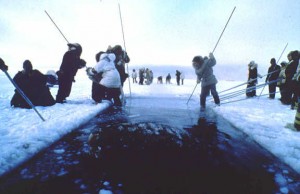Big Miracle
Posted on February 2, 2012 at 6:00 pm
B+| Lowest Recommended Age: | 4th - 6th Grades |
| MPAA Rating: | Rated PG for language |
| Profanity: | Brief strong language |
| Alcohol/ Drugs: | Alcohol, character gets tipsy |
| Violence/ Scariness: | Human and animal characters in peril, references to hunting and eating whales, sad animal death |
| Diversity Issues: | Diverse characters |
| Date Released to Theaters: | February 3, 2012 |
| Date Released to DVD: | June 18, 2012 |
| Amazon.com ASIN: | B005LAIGQ4 |
“You’re not as easy to hate as I thought,” an oil man tells an environmental activist in “Big Miracle,” the heartwarming true story of a 1987 effort to rescue three Alaskan whales. It could just as well have been said by any of the more than a dozen lead characters who find themselves part of a “cockeyed coalition.” People who viewed each other with suspicion, if not downright animosity, are brought together to save a family of whales affectionately named after Flintstones characters.
The obstacle for the whales was five miles of ice that had to be cut away in sub-zero temperatures so the whales could get to the ocean. The bigger obstacle was the struggle for the humans to try to find a way to work together.
“Big Miracle” is the story of a rescue operation put together by people who each wanted something different. Native Inupiat whale hunters wanted to “harvest” (kill and eat) the whales. Environmentalists wanted to protect them. The US military did not want to ask for help from a Soviet ice cutting ship. An oil developer wanted to improve his reputation. Two Minnesota entrepreneurs wanted to show off their ice melting machine. Politicians wanted to look good or look innocent. And journalists wanted a story.
Director Ken Kwapis and screenwriters Jack Amiel and Michael Begler deftly keep the multi-character story from getting too cluttered with the help of appealing performances that give us an instant connection to the humans who are literally trying to save the whales. Standouts in the cast include John Krasinski as a television reporter who is tired of being stuck in a backwater where nothing exciting happens, Kathy Baker as an unexpected supporter with inside information, Dermot Mulroney as a frustrated military officer, and John Pingayeck on his first movie role as a grandfather trying to teach his grandson to listen to the world outside his earphones.
When the reporter’s story is picked up for a national broadcast, the first to arrive is Rachel (an earnest and believably bedraggled Drew Barrymore). She is an environmental activist with no resources but a good story. One by one, those who resist getting involved revise their positions when they are in the spotlight. No one wants to risk bad publicity–or pass up the chance to look heroic.
Even as the people come together, the logistical challenge becomes overwhelming and — parent alert — the ultimate rescue is bittersweet, not entirely triumphant.
The people stories, especially a trumped-up romantic triangle, are not as intriguing as the portrayal of pre-Internet news media. With only three network news broadcasts just half an hour each evening, everyone from school children to White House staffers watched the same stories. The archival footage is like the hub that holds all the parts of the story together, and there are some pointed jabs at media focus on the sensational over the significant.
A turning point comes when White House aide Kelly Meyers (based on Bonnie Carroll) persuades President Ronald Reagan, at the end of his term, to call on his counterpart in the USSR for help from a Soviet ice cutting ship. (Be sure to watch for photos of Carroll’s real life wedding to the military officer she met at the rescue over the closing credits.).
Meyers sets up a “Hello Gorby, this is Ronnie” phone call that serves as a literal ice breaker for the whales and a metaphorical one for two nations in the very earliest stages of post-Evil Empire relations. The people saved the whales, but the real miracle was that they learned their differences were small compared to what they had in common with each other and with the giant mammals who needed their help.
Parents should know that this movie includes animal and human peril and references to hunting and eating whales. One of the whales dies (off-screen).
Family discussion: How many different reasons did the characters have for helping the whales? How did the risk of bad publicity or the benefits of good publicity change their behavior? What is different now from the era when this took place?
If you like this, try: “Free Willy” and “Whale Rider” and the book about the real-life rescue by Tom Rose

